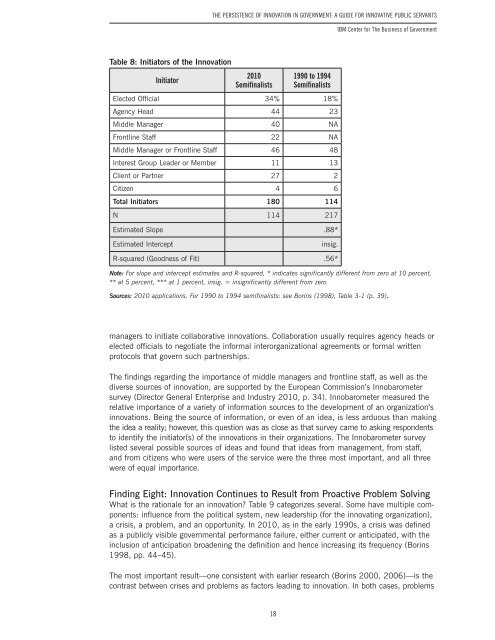<strong>The</strong> <strong>Persistence</strong> <strong>of</strong> <strong>Innovation</strong> <strong>in</strong> <strong>Government</strong>: A Guide for Innovative Public Servantswww.bus<strong>in</strong>ess<strong>of</strong>government.orgElements <strong>of</strong> Cont<strong>in</strong>uityWhile there have been significant changes <strong>in</strong> the landscape <strong>of</strong> American public sector <strong>in</strong>novation,a great many th<strong>in</strong>gs rema<strong>in</strong> relatively constant, particularly process. <strong>The</strong> next set <strong>of</strong> f<strong>in</strong>d<strong>in</strong>gsfocus on the process <strong>of</strong> <strong>in</strong>troduc<strong>in</strong>g and implement<strong>in</strong>g an <strong>in</strong>novation, factors lead<strong>in</strong>gs tothe <strong>in</strong>novation, and the analytical process for mov<strong>in</strong>g from an <strong>in</strong>spiration to a program design.F<strong>in</strong>d<strong>in</strong>gs on the obstacles faced by <strong>in</strong>novators, and the tactics they use to overcome them, arealso presented.F<strong>in</strong>d<strong>in</strong>g Seven: <strong>Innovation</strong> Cont<strong>in</strong>ues to Orig<strong>in</strong>ate at All Organizational Levels<strong>The</strong> subtitle <strong>of</strong> Innovat<strong>in</strong>g with Integrity: How Local Heroes are Transform<strong>in</strong>g American<strong>Government</strong>—the book that first analyzed the HKS Awards data—was <strong>in</strong>tended to encapsulateone <strong>of</strong> its key f<strong>in</strong>d<strong>in</strong>gs: frontl<strong>in</strong>e public servants and middle managers are the most frequent<strong>in</strong>itiators <strong>of</strong> <strong>in</strong>novations (Bor<strong>in</strong>s, 1998). This was surpris<strong>in</strong>g at the time, given theprevail<strong>in</strong>g top-down and politically risk-averse image <strong>of</strong> public management. This f<strong>in</strong>d<strong>in</strong>grema<strong>in</strong>s true for the 2010 semif<strong>in</strong>alists.Table 8 shows the pattern <strong>of</strong> answers to the HKS semif<strong>in</strong>alist application’s question about <strong>in</strong>itiators<strong>of</strong> <strong>in</strong>novations: “What <strong>in</strong>dividuals or groups are considered the primary <strong>in</strong>itiators <strong>of</strong> yourprogram?” Innovat<strong>in</strong>g with Integrity did not differentiate between frontl<strong>in</strong>e staff and middlemanagers. Subsequent research (Bor<strong>in</strong>s 2000, 2006) has, and has found both groups wellrepresented, a f<strong>in</strong>d<strong>in</strong>g that persisted for the 2010 semif<strong>in</strong>alists.<strong>The</strong> applications tell stories about <strong>in</strong>itiators <strong>of</strong> different backgrounds and personalities. <strong>The</strong>seare elected <strong>of</strong>ficials with a vision who receive public support and then direct the bureaucracyto make their vision a reality. In contrast, there are frontl<strong>in</strong>e and middle manager <strong>in</strong>itiatorswho have a vision and then build support for it with<strong>in</strong> government.Kentucky gubernatorial candidate Steve Breshear, who made open government a key theme <strong>in</strong>his 2007 campaign, mandated the construction <strong>of</strong> the state’s OpenDoor transparency portalimmediately upon tak<strong>in</strong>g <strong>of</strong>fice. New York Mayor Michael Bloomberg, <strong>in</strong>fluenced by PresidentObama’s advocacy <strong>of</strong> citizen service <strong>in</strong> his first <strong>in</strong>augural address, directed two staff membersto design a program <strong>in</strong> a few weeks. <strong>The</strong> result was the NYC Service program, which givesthousands <strong>of</strong> New York City residents mean<strong>in</strong>gful opportunities to volunteer; for example, byhelp<strong>in</strong>g <strong>in</strong> the H1N1 virus vacc<strong>in</strong>ation <strong>in</strong>itiative. NYC Service was selected as one <strong>of</strong> the sixHKC awards f<strong>in</strong>alists <strong>in</strong> 2010.<strong>Innovation</strong> also occurs on the front l<strong>in</strong>e. For example, Allison Hamilton, a middle manager <strong>in</strong>Oregon’s Department <strong>of</strong> Transportation, developed a plan to locate solar panels on <strong>in</strong>terstateright-<strong>of</strong>-ways and use the energy to power lights for the highway. To make the plan a reality,she needed and very effectively secured the support <strong>of</strong> her superiors, other Oregon departments,and the Federal Highway Adm<strong>in</strong>istration for what became Oregon’s Solar HighwayProgram (Bor<strong>in</strong>s, 2014, pp. 67–68).In 2010, semif<strong>in</strong>alists <strong>in</strong>cluded a higher percentage <strong>of</strong> projects <strong>in</strong>itiated by elected <strong>of</strong>ficials,agency heads, and program clients or partners than <strong>in</strong> the early 1990s. This may be theresult <strong>of</strong> the much greater level <strong>of</strong> <strong>in</strong>terorganizational collaboration displayed by the 2010semif<strong>in</strong>alists.<strong>The</strong> identification <strong>of</strong> a program’s clients or collaborators as <strong>in</strong>itiators for 27 percent <strong>of</strong> the2010 semif<strong>in</strong>alists, as opposed to two percent for the 1990 to 1994 semif<strong>in</strong>alists (Table 8),is further evidence <strong>of</strong> that trend. With<strong>in</strong> the traditional vertical authority relationships thatstill govern public sector organizations and agencies, it is difficult for frontl<strong>in</strong>e staff or middle17
<strong>The</strong> <strong>Persistence</strong> <strong>of</strong> <strong>Innovation</strong> <strong>in</strong> <strong>Government</strong>: A Guide for Innovative Public ServantsIBM Center for <strong>The</strong> Bus<strong>in</strong>ess <strong>of</strong> <strong>Government</strong>Table 8: Initiators <strong>of</strong> the <strong>Innovation</strong>Initiator2010Semif<strong>in</strong>alists1990 to 1994Semif<strong>in</strong>alistsElected Official 34% 18%Agency Head 44 23Middle Manager 40 NAFrontl<strong>in</strong>e Staff 22 NAMiddle Manager or Frontl<strong>in</strong>e Staff 46 48Interest Group Leader or Member 11 13Client or Partner 27 2Citizen 4 6Total Initiators 180 114N 114 217Estimated Slope .88*Estimated Intercept<strong>in</strong>sig.R-squared (Goodness <strong>of</strong> Fit) .56*Note: For slope and <strong>in</strong>tercept estimates and R-squared, * <strong>in</strong>dicates significantly different from zero at 10 percent,** at 5 percent, *** at 1 percent, <strong>in</strong>sig. = <strong>in</strong>significantly different from zeroSources: 2010 applications. For 1990 to 1994 semif<strong>in</strong>alists: see Bor<strong>in</strong>s (1998), Table 3-1 (p. 39).managers to <strong>in</strong>itiate collaborative <strong>in</strong>novations. Collaboration usually requires agency heads orelected <strong>of</strong>ficials to negotiate the <strong>in</strong>formal <strong>in</strong>terorganizational agreements or formal writtenprotocols that govern such partnerships.<strong>The</strong> f<strong>in</strong>d<strong>in</strong>gs regard<strong>in</strong>g the importance <strong>of</strong> middle managers and frontl<strong>in</strong>e staff, as well as thediverse sources <strong>of</strong> <strong>in</strong>novation, are supported by the European Commission’s Innobarometersurvey (Director General Enterprise and Industry 2010, p. 34). Innobarometer measured therelative importance <strong>of</strong> a variety <strong>of</strong> <strong>in</strong>formation sources to the development <strong>of</strong> an organization’s<strong>in</strong>novations. Be<strong>in</strong>g the source <strong>of</strong> <strong>in</strong>formation, or even <strong>of</strong> an idea, is less arduous than mak<strong>in</strong>gthe idea a reality; however, this question was as close as that survey came to ask<strong>in</strong>g respondentsto identify the <strong>in</strong>itiator(s) <strong>of</strong> the <strong>in</strong>novations <strong>in</strong> their organizations. <strong>The</strong> Innobarometer surveylisted several possible sources <strong>of</strong> ideas and found that ideas from management, from staff,and from citizens who were users <strong>of</strong> the service were the three most important, and all threewere <strong>of</strong> equal importance.F<strong>in</strong>d<strong>in</strong>g Eight: <strong>Innovation</strong> Cont<strong>in</strong>ues to Result from Proactive Problem Solv<strong>in</strong>gWhat is the rationale for an <strong>in</strong>novation? Table 9 categorizes several. Some have multiple components:<strong>in</strong>fluence from the political system, new leadership (for the <strong>in</strong>novat<strong>in</strong>g organization),a crisis, a problem, and an opportunity. In 2010, as <strong>in</strong> the early 1990s, a crisis was def<strong>in</strong>edas a publicly visible governmental performance failure, either current or anticipated, with the<strong>in</strong>clusion <strong>of</strong> anticipation broaden<strong>in</strong>g the def<strong>in</strong>ition and hence <strong>in</strong>creas<strong>in</strong>g its frequency (Bor<strong>in</strong>s1998, pp. 44–45).<strong>The</strong> most important result—one consistent with earlier research (Bor<strong>in</strong>s 2000, 2006)—is thecontrast between crises and problems as factors lead<strong>in</strong>g to <strong>in</strong>novation. In both cases, problems18


